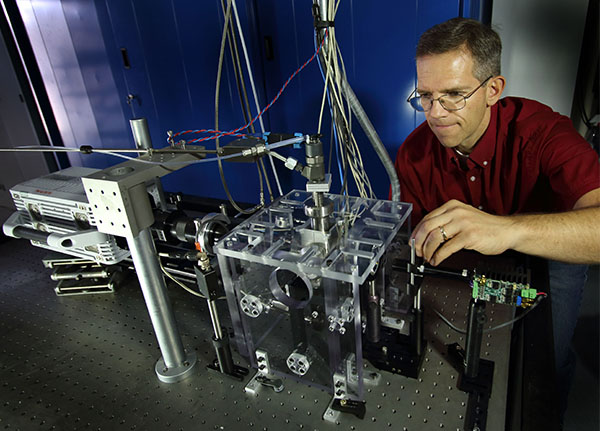Sandia spearheads three-year industry-funded agreement
Sandia has formed an industry-funded Spray Combustion Consortium focusing on improved understanding and modeling tools for fuel injection. Control of fuel sprays is key to the development of clean, affordable, fuel-efficient engines.
Intended for industry, software vendors, and national laboratories, the consortium provides a direct path from fundamental research to validated engineering models ultimately used in combustion engine design. The three-year consortium builds on work generated under DOE-funded research projects and will develop predictive engine fuel injector nozzle flow models and methods to couple them to spray development outside the nozzle.

Consortium participants include Sandia and Argonne national laboratories, University of Massachusetts at Amherst, Toyota, Renault, Convergent Science, Cummins, Hino Motors, Isuzu, and Ford. Data, understanding of the critical physical processes involved, and initial computer model formulations are being developed and provided to all participants.
Lyle Pickett (8362), who serves as the primary lead for the consortium at Sandia, says predictive spray modeling is critical in the development of advanced engines.
“Most pathways to higher engine efficiency rely on fuel injection directly into the engine cylinder,” says Lyle. “While industry is moving toward improved direct-injection strategies, they often encounter uncertainties associated with fuel injection equipment and in-cylinder mixing driven by fuel sprays. Characterizing fuel injector performance for all operating conditions becomes a time-consuming and expensive proposition that seriously hinders engine development.”
Industry has consequently identified predictive models for fuel sprays as a high research priority supporting the development and optimization of higher-efficiency engines. Sprays affect fuel-air mixing, combustion, and emission formation processes in the engine cylinder; understanding and modeling the spray requires detailed understanding of flow within the fuel injector nozzle as well as the dispersion of liquid outside of the nozzle. However, nozzle flow processes are poorly understood and quantitative data for model development and validation are extremely sparse.
“The Office of Energy Efficiency and Renewable Energy/Vehicle Technologies Office supports the unique research facility utilized by the consortium to elucidate sprays and also supports scientists at Sandia in performing experiments and developing predictive models that will enable industry to bring more efficient engines to market,” says Gurpreet Singh, program manager at DOE’s Vehicle Technologies Office.
Performing experiments to measure, simulate, model
As part of the consortium, several experiments are underway using different nozzle shapes, transparent and metal nozzles, and gasoline and diesel type fuels. The experiments provide quantitative data and a better understanding of the critical physics of internal nozzle flows, using advanced techniques like high-speed optical microscopy, X-ray radiography, and phase-contrast imaging.
The experiments and very detailed simulations of the internal flow, cavitation, flash-boiling, and liquid breakup processes are used as validation information for engineering-level modeling that is ultimately used by software vendors and industry for the design and control of fuel injection equipment.
The goals of the research are to reveal the physics that are general to all injectors and to develop predictive spray models that are ultimately used in combustion design.
“Predictive spray modeling is a critical part of achieving accurate simulations of direct injection engines,” says Kelly Senecal, co-founder of Convergent Science. “As a software vendor specializing in CFD of reactive flows, the knowledge gained from the data produced from the consortium is invaluable to our future code development efforts."
Delivering results
Consortium participants meet on a quarterly basis to share information and provide updates.
“The consortium addresses a critical need impacting the design and optimization of direct injection engines,” says Lyle. “The deliverables of the consortium will offer a distinct competitive advantage to both engine companies and software vendors.”